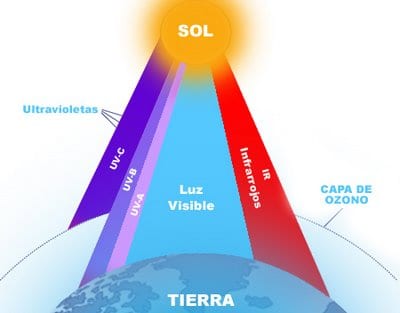Perhaps we have ever wondered what type of radiation reaches Earth, in this regard it is known that the fundamental input of radiation on the planet is the radiation emitted by the Sun, inside which a continuous process of conversion of hydrogen into helium takes place, which releases enormous amounts of heat. This heat escapes from the interior of the Sun to its surface and from it to the Earth.
This energy is transmitted to Earth in the form of electromagnetic waves, which have different lengths. The set of the different wavelengths emitted by a body is called spectrum of that body and is closely related to its temperature, in such a way that the higher it is, the shorter the wavelengths emitted by it.
The set of wavelengths emitted by the Sun is called the solar spectrum and in it, logically, very small wavelengths predominate, as corresponds to its very high temperature, which is evaluated in about 6.000 K (5.727 ° C).
Within the solar spectrum, three types of fundamental radiation can be distinguished:
to the ultraviolet rays, with wavelengths between 0, 1 and 0,4 micrometers, and that transport together with X-rays and gamma rays 9% of the total energy emitted by the Sun.
b) The rays visible or luminous, with higher wavelengths - between 0,4 and 0,78 micrometers - and which transport approximately 41% of the total solar energy.
c) The infrared rays, with wavelengths predominantly between 0,78 and 3 microns (the band corresponding to the near infrared), and which transport the remaining 50% of solar energy.
All these radiations originate from the Sun and first reach the upper limit of the atmosphere. Now this mean value hides a distribution very uneven of radiation between different latitudes, inequalities that respond to the way the Earth-atmosphere system intercepts solar radiation.


this good
Hello Antonio, thanks for this article, it is very good since I have to make a report about solar energy and your article summarizes the types of radiation that exist in solar radiation. I quote you in the report as follows:
Castillo, AE (March 2, 2014). Radiation on the Earth's surface – Meteorología en Red. Retrieved on October 21, 2014, from http://www.meteorologiaenred.com/la-radiacion-en-la-superficie-terrestre.html#
Regards!